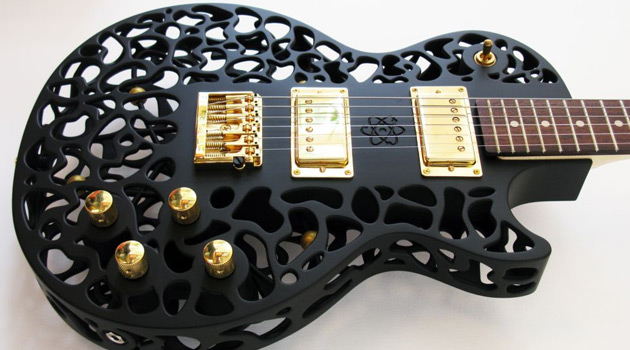Technology
3D Printers Shape The Way We Make Music

With the advent of 3D printing, musical instruments will never be the same. Custom designs, sizes, materials, colors — it’s all possible now. One man at the forefront of this nascent movement is New Zealand-born designer Olaf Diegel, who teaches Product Development at Lund University in Sweden. So far, he has successfully made half a dozen guitars, a piano, and a drum kit design using a 3D printer.
First, he created an electric guitar design, which took about 11 hours to print and played perfectly when it was finished. Then, he ramped up the difficulty with an electric bass, which requires a stronger neck and body due to the thick strings. Finally, in a partnership with the 3D Systems printing company, he managed to produce a keyboard and drum set. Where did Diegel get his inspiration for these futuristic designs? He hearkened back to his younger days as a rock musician, where he had his first dalliance with a 3D printer. Since he was able to see the technology evolve over the years, he realized that eventually it would be used to make objects in many industries.
Once a guitar body has been printed, for example, the entire body is custom painted. Then, the appropriate hardware and electronics are installed onto the frame. When it comes to unconventional shapes and intricate bodies, 3D printing is the only option. Although a 3D-printed instrument might draw skepticism from a life-long musician, the sound quality and build structure is actually at the same level as any major manufacturer. In fact, a number of professional musicians have gotten their hands on Diegel’s printed pieces, and they’ve been decidedly impressed. As the 3D printing process becomes more accepted within the music industry, Diegel will most likely continue working on new designs. Currently, he’s making a new iteration of his printed saxophone and has a wholly new design for a flute that can simultaneously play chords and a lead melody.
Aside from instruments, it’s thrilling to think about how 3D printing could revolutionize other areas of the music industry. For example, imagine if you could record your own music with a computer, mix it, and then print the finished product onto vinyl with your personal 3D printer. It would be a huge shift for recorded music, as it effectively would put record labels into the hands of people. More than CDs or cassettes, vinyl has been seen as a high standard of a musical project. These days, people are more willing to purchase vinyl over any other physical format.
So, you start with a 3D-printed guitar, bass, and keyboard; then, you record and release your music via your vinyl record printer. Perhaps you print each vinyl in a unique color, or you engrave a special design into every copy. Finally, you sell your LPs online and at gigs, and all of the money goes straight to the band. It’s a dream scenario for musicians, and it’s slowly coming true.
















Recent Comments